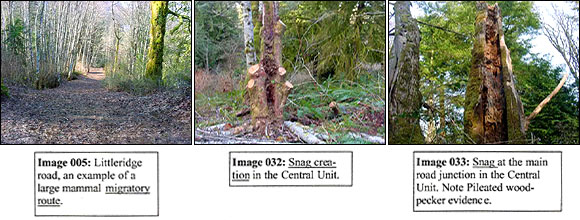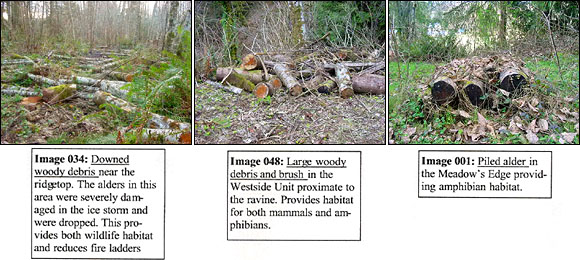















1. Cover Page
2. Table of Contents
3. Objectives
4. Property
5. Resources
5.1 Forest Health
5.2 Soils
5.3 Water Resource
5.4 Timber
5.5 Wildlife
5.6 Forest Grazing
5.7 Aesthetics and
Recreation
5.8 Forest Products
6. 10-Year Plan
|
|
|
Forest Stewardship Plan
5.5 Wildlife Habitat
Wild Thyme Farm forest harbors various types of wildlife, some resident and some intermittent. Due to the overall lack of knowledge about the habitat needs of present species and the desire of the landowner to enhance them, I feel that SIP funds for wildlife enhancement should be seriously considered.
The following species assessments should be taken with the understanding that no formalized wildlife surveys have been done on the Wild Thyme Farm forest property. Hence they do not claim to be complete or entirely accurate, however they provide a compilation, albeit incomplete, of species who are known on the West side of the Cascade mountain range and who’s habitat and forage overlap the habitat types encompassed by the Wild Thyme Farm forest.
Upland Game Birds (Bird Image Guide)
Upland game birds previously sighted consist of Ruffed grouse (Bonasa umbelius) and Wild turkey (Melegris gallopavo). These two species have an inverse relationship: the Ruffed grouse is associated with early successional forests while the Wild turkey has increased in later years as forests, on the landscape level, have increased in late successional characteristics. In the Wild Thyme Farm forest there is little danger at this time of one ousting the other. As the forest matures, however, this should be taken into account in future wildlife assessments (Appendix I, Various Images).
Hawks, Owls, Woodpeckers, or Songbirds
There are a multitude of birds species associated with the Wild Thyme Farm forest habitat type, including hawks, owls, woodpeckers, and songbirds. Some of the following species have been observed, evidence has been found of the presence of others, and other are supposed to be present but not verified.
Hawk-type birds include the Cooper’s hawk (Accipiter cooperii), the Sharp-shinned hawk (Accipiter striatus), and the Red-tailed hawk (Buteo jamaicensis). The Sharp-shinned hawk’s presence is questionable but is likely to increase as late successional forest cover develops.
There is prolific evidence of woodpeckers and woodpecker-associated species. These include the Brown creeper (Certhia americana), the Red-breasted nuthatch (Sitta canadensis), the Pileated woodpecker (Dryocorpus pileatus), the Hairy woodpecker (Picoides villosus), and the Red-breasted sapsucker. The Pileated woodpecker is present in large numbers, as evidenced by the multiple borings in snags throughout the property. The Dark-eyed junco (Junco hyemalis) and the Spotted towhee (Pipilo maculatus) are also likely residents (Appendix I, Various Images).
Large Mammals (Mammal Image Guide)
Due to the relatively small size of the Wild Thyme Farm forest, it is likely that the majority of large mammals viewed at this site, with the possible exception of deer, utilize the forest only as a migration route, temporary cover, and occasional forage. Mammals sighted on the property include deer (Odocoileus hemionus), elk (Cervis elaphus), Black bear (Ursus americanus), coyote (Canis latrans), and cougar (Felis concolor) (Appendix I, Various Images).
Small Mammals
Small mammals perform a notable role in the forest ecosystem in that they dually control the populations of smaller species while also serving as a food source to larger mammals. There are a multitude of small mammals in the Wild Thyme Farm forest, including, but not limited to, raccoon (Procyon lotor), Western gray squirrel (Sciurus grisues), Northern flying squirrel (Glaucomys sabrinus), and the American beaver (Castor canadensis). Also observed is an unidentified species of rabbit (Appendix I, Various Images).
Amphibians and Reptiles (Amphibian Image Guide)
Prolific debris on the forest floor and the presence of hydrologic features make amphibians and salamanders a viable wildlife species. Amphibians are often perceived as an indicator of overall environmental health and should be perceived as such in the future. Species include Pacific giant salamander (Dicamptodon tenebrosus), Ensatina (Ensatina eschscholtzi), the Rough-skinned newt (Taricha granulosa), and the Red-legged frog (Rana aurora). Other species who may find suitable habitat in the Wild Thyme Farm Forest but whose presence is not confirmed include the Tailed frog (Ascaphus truei), the Bullfrog (Rana catesbeiana), and the Long toed salamander (Ambystoma macrodactylum)(Appendix I, Various Images).
Enhancement and Protection
Mammals (Mammal Image Guide)
There has been more than adequate enhancement and maintenance of mammal habitat. Patches of cover are retained across the property. Hay and other forage mixed are or soon will be cultivated in the upper meadow as forage. Downed woody debris has been retained in prolific amounts. Closed forest roads serve as travel corridors during the winter, enabling mammals to migrate undisturbed (Image 005). All fencing used on the farm is made of smooth wire and is not prone to cause injury. There are multiple brush piles throughout the property. Care is taken to minimize damage to browse and hardwood trees while thinning.
Management Recommendations
I do not recommend that wildlife management specifically directed towards mammals be pursued in this forest for the following reasons.
Deer do not face significant habitat threats at this time due to their rapid adaptation to suburban settings. Elk, while not prolific, do not face significant threats at this time but population health should be monitored and habitat cultivated if the population becomes threatened. The browse required by deer and elk is already plentiful due to rapid undergrowth regeneration since the ice storm. Most additional browse necessary could be found readily on surrounding forestland. Management for bear, coyote, mountain lion, and bobcat must be perceived in the context of their close proximity to human activity and presence in a forest with educational and recreation objectives. The adverse effects of intentionally managing for these species may outweigh their costs, both economic and otherwise, especially considering their probable presence regardless. However, the scat of these animals can and should be used to assess small mammal presence at Wild Thyme Forest and on surrounding forestland.
The migration of large mammals through this forest will most likely persist, at least for the time being, without direct enhancement efforts. Hence I feel that SIP fund could be better utilized enhancing habitat for other animals.

Birds (Bird Image Guide)
Snags that are particularly viable are left intentionally to provide bird habitat (Image 033) and in areas snags are created (Image 032). Wolf trees are left for the purpos of habitat. There are adequate grasses and clovers in the main farm complex, and their pesticide/herbicide-free status makes them safe for bird consumption. There have been no nest boxes installed yet. Shrubby vegetation has been retained throughout the property. Some trees are left unpruned, many harboring grandiose branching near the base of the trunk. Large live trees are ubiquitously retained. Fruits and nuts are planted in the main farm complex and are encouraged in the forested area.
Management Recommendations
Birds should be seriously considered as a target wildlife enhancement species. This consists of increasing the prevalence of their resource needs, namely cover, water, and food. While cover is adequate at this time it could be enhanced through bird boxes. The procedural aspects of bird box installation should be researched. Water can be incorporated into overall enhancement of the ravines as well as the pond creation program, which could attract migrating species along their routes. Another enhancement practice to be experimented with would be the increase in food source through the cultivation of insect habitat. One option is through bundling downed wood, simulating larger snags, which, when inhabited, can provide increased structural diversity for insect species. This however should be pursued with caution, as aggrandized insect populations can have adverse effective on live foliage. Other methods for this should be researched.
A bird survey could be performed if economically feasible, as it would be beneficial to the landowner for management and personal reasons.
Amphibians and Reptiles (Amphibian Image Guide)
There is sufficient downed woody debris to provide amphibian and reptile habitat (Image 034). There are multiple brush piles across the property (Image 048). There are no talus slopes around which to retain a forested buffer, and rock piles would not be advised as there is no naturally occurring rock on the property. The pond creation practice is ongoing. The vegetation around streams and headwaters is being actively restored.

Management Recommendations
Amphibian and reptile population should be targeted for enhancement through SIP funds and contextualized within overall riparian restoration. The bundling of woody debris, namely downed alder, could dramatically increase amphibian and reptile habitat (Image 001). Other methods of habitat creation should be researched.
As with the various bird species, there has been no amphibian survey done, and it would be beneficial to perform one when it becomes viable.
|


